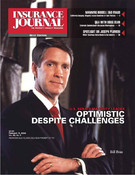Attorney General Brian Sandoval announced that the Nevada Department of Justice, Insurance Fraud Unit, obtained more convictions per capita than any other state. The statistics for insurance crimes were compiled by the Coalition Against Insurance Fraud late last year for each of 43 states that have fraud investigation and prosecution bureaus. The Coalition, in an end-of-year publication for 2003, stated: “Nevada convicted the most swindlers per capita last year, logging about 10 convictions for every 100,000 residents.” A recent national survey of public attitudes about insurance fraud reveals one of four people say it is okay to lie to one’s insurance company in order to obtain money. Senior Deputy Attorney General Marty Howard, Director of the IFU, finds these statistics very disturbing. “You would think more people would realize that lying to their insurance company to obtain undeserved benefits is stealing and is therefore morally wrong. You would think that the possibility of being caught and punished would deter those who don’t. For some it does. For the rest, well, the chances are very good that they’ll be dealing with us. It is not a victimless crime. Honest policyholders pay the cost for insurance fraud.” Howard also described the severe criminal penalties for insurance fraud: “Insurance fraud is a felony in Nevada just like grand larceny or theft. You can go to prison for up to five years and face a $5,000.00 fine. A felony conviction affects not only your freedom, but your right to vote, your right to hold certain jobs, and will severely impact your family. We intend to continue to get this message out and get dishonest people to think a little more seriously about the consequences of filing false insurance claims.” Insurance fraud is one of the costliest white-collar crimes in the United States, ranking second only to tax evasion. A study by Hartford, Connecticut-based Conning & Co. estimated that fraud costs the insurance industry $96 billion dollars annually. One figure stands out in the report; that insurance fraud costs families $5,000 each year. This amount includes not only higher premiums, but also the resulting higher prices for consumer goods and services.
Topics Fraud
Was this article valuable?
Here are more articles you may enjoy.


 Microsoft Tells Texas Agencies They Were Exposed in Russian Hack
Microsoft Tells Texas Agencies They Were Exposed in Russian Hack  As Rates Rise, Majority of Homeowners Say Insurance Industry Is in Crisis: Survey
As Rates Rise, Majority of Homeowners Say Insurance Industry Is in Crisis: Survey  US Roof Maintenance Lags: Hanover
US Roof Maintenance Lags: Hanover  Allstate, Nationwide Post Dramatic Q12024 Homeowners Loss Ratio Drops: S&P
Allstate, Nationwide Post Dramatic Q12024 Homeowners Loss Ratio Drops: S&P 


